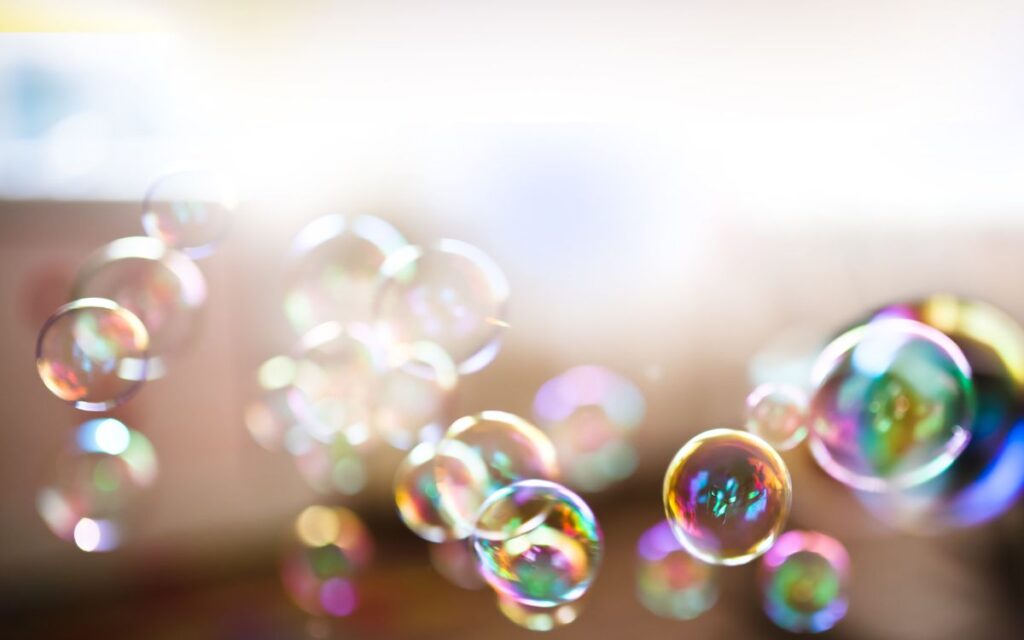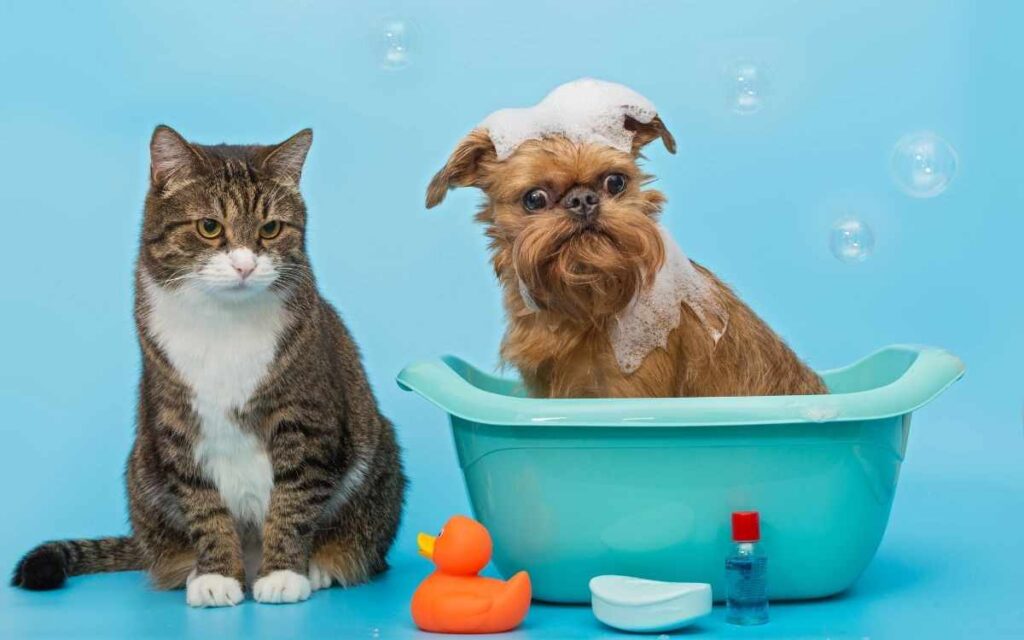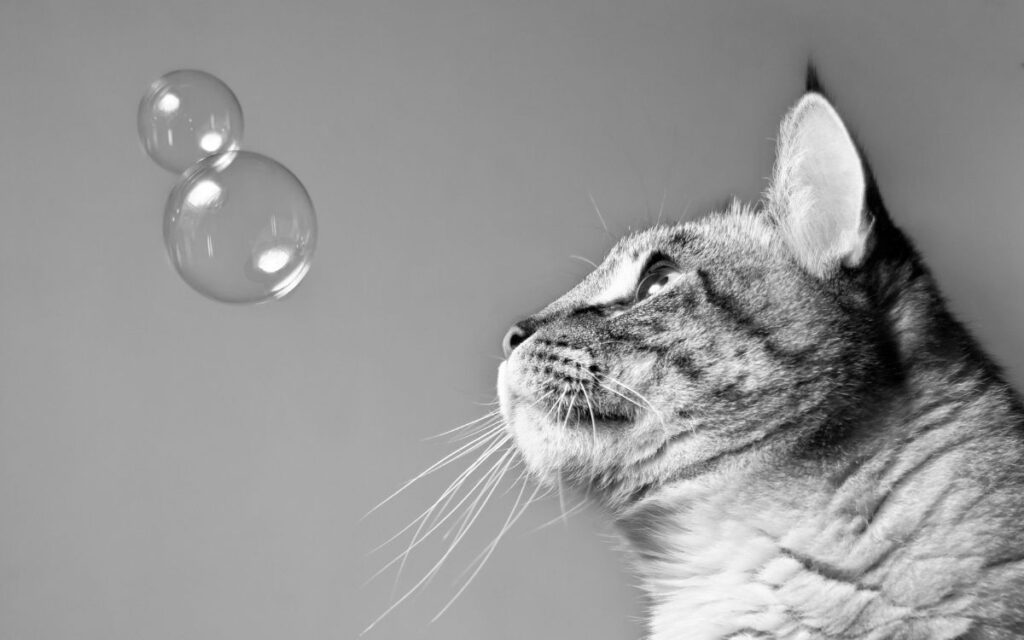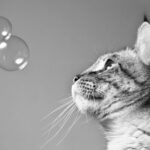Domestic or wild cats, all have the same innate desire to stalk and hunt. As dedicated cat owners, we always seek for new methods to entertain and amuse our feline friends. Incorporating bubbles into their playtime is one unusual yet fascinating strategy.
But before you eagerly go for the bubble wand, there’s an important query: “Are they safe for cats?” We will dive into the world of cats in this post and answer worries about their safety. Floating bubbles provide an entertaining and unpredictable challenge that attracts your cat’s natural hunting instincts while conventional cat toys may be predictable and simple to catch.
What Are Bubbles Made Of?
These are typically made from a simple mixture of water, soap, and sometimes a bit of glycerin. This results in the formation of an air-enclosed thin coating of soapy liquid. When air is blown into this combination, a bubble forms, with the soap molecules on the bubble’s surface trapping the air within and giving it a spherical shape.

Sometimes, glycerin is also used, which makes bubbles more resilient and long-lasting by reducing the rate at which water evaporates from their surface. Some bubble solutions also contain essential cat oils or even catnip. This makes bubbles cat-friendly and non-toxic. But also keep in mind that, most of the bubble solutions are safe but not all!
Why Do Cats Like Bubbles?
Cats are naturally drawn to bubbles and love to play with them for several intriguing reasons:
Movement and Instinct:
As they float and pop, bubbles make irregular and unexpected movements that resemble the fast, darting movements of small prey creatures like insects or birds. This stimulates a cat’s natural hunting instinct, making them want to play and pounce.
Visual Stimulation:
A cat is drawn to the reflective, shimmering surface of bubbles. Cats’ visual senses can be stimulated by the play of light and the way bubbles change shape as they float.
Auditory Interest:
Cats can be attracted to its delicate popping sound that they create when they break. This additional layer of interest during play results from the auditory stimulus.
Interactive Play:
Bubbles provide a distinctive form of participatory play. They make for an interesting activity since they challenge cats to utilize their agility and coordination to chase and catch the elusive bubbles.

Physical Exercise:
Chasing bubbles encourages physical activity, which is essential for a cat’s overall health and well-being. It provides exercise for their muscles and helps prevent boredom.
Are Bubbles Safe for Cats?
Safety comes first when it comes to cats and bubbles. If handled carefully, bubbles can indeed be safe for cats. Since most commercially available bubble solutions are carefully made to be non-toxic, our feline friends can often use them without concern.

But it’s important to keep a few important things in mind. First of all, constant supervision is necessary during bubble activity to prevent your cat from accidentally ingesting the bubble solution, which can cause intestinal problems. Second, some cats may be allergic or sensitive to certain components in bubble solutions. It is advisable to stop playing with bubbles right once if you see any symptoms of an allergic reaction, such as excessive itching, sneezing, or watery eyes.
How to Make DIY-Safe Bubbles for Cats
If you are wondering how to make DIY bubbles for your cat, then here is an easy DIY recipe for you.
Just follow these steps:
Ingredients
Water
Dish soap (non-toxic and fragrance-free)
Plastic bottle
Bubble wand
Preparation
Mix one part of dish soap with ten parts of water. Ensure it’s non-toxic and free from any additives that could harm your cat.
Testing
Before using the solution on your cat, test a small amount on a non-sensitive area of their fur to check for any adverse reactions.
What Are Catnip Bubbles?
Traditional bubbles are modified with the use of catnip extract, to create catnip bubbles. When cats sniff or eat catnip, it is known to cause a euphoric and playful response. The fun of chasing bubbles is combined with the additional allure of the catnip fragrance in catnip bubbles.
Here’s how catnip bubbles work:
When you blow catnip bubbles, they release the scent of catnip into the air.
Cats, attracted by the familiar and stimulating scent, may become even more enthusiastic about chasing and capturing the bubbles.
It’s important to remember that not all cats react to catnip, and the intensity of their response can vary. Some cats may go wild for catnip bubbles, while others may show little interest.
Tips for Safe Bubble Play with Your Cat
1. Use Cat-Safe Bubble Solutions
Opt for bubble solutions specifically designed for pets, as they are less likely to contain harsh chemicals or fragrances that could irritate your cat’s skin or eyes.
2. Control the Environment
Choose a safe and controlled environment for bubble play, free from hazards like sharp objects or obstacles that your cat could accidentally run into while chasing bubbles.
3. Limit Playtime
Moderation is key. Avoid extended periods of bubble play, as your cat may become overstimulated. Short, supervised sessions are ideal.

Can cats have an allergy to bubble solution?
Yes, cats can have allergies or sensitivities to the ingredients found in bubble solutions. Just like humans, cats may react adversely to certain substances.
The components in bubble solutions that can potentially trigger allergies or sensitivities in cats include:
Fragrances: Some bubble solutions contain fragrances or scents, which may irritate a cat’s sensitive nose and skin. Cats with fragrance allergies might exhibit signs of discomfort or allergic reactions.
Chemicals: Some bubble solutions may contain chemicals or additives that could be harsh on a cat’s skin, eyes, or digestive system. These chemicals might lead to itching, sneezing, or gastrointestinal issues.
Dyes: Colored bubble solutions may contain dyes that cats can be sensitive to. Ingesting or coming into contact with these dyes might lead to adverse reactions.
If you notice any of the following signs in your cat during or after bubble play, it’s essential to discontinue the activity and consult with your veterinarian:
- Excessive scratching or itching
- Sneezing or watery eyes
- Skin redness or irritation
- Vomiting or diarrhea (if the solution is ingested)
To minimize the risk of allergies or sensitivities, it’s advisable to opt for bubble solutions specifically designed for pets, as they are more likely to be formulated with non-toxic and hypoallergenic ingredients. Additionally, always supervise your cat during bubble play to ensure their safety and well-being.

Conclusion
If your cat gets bored of traditional toys, then introducing bubbles to them may be the best option. The shimmering, circular appearance and popping sound of bubbles, attracts cat towards them. But make sure that bubbles should be made of non-toxic solutions and should not harm the cat. Use essential oil-containing bubble solutions instead of harsh chemicals.
To know more about cats, visit funnycatvideos.us
FAQ Section
Can Kittens Play with Bubbles?
Yes, Why not? Kittens can play with bubbles, but make sure that the bubbles are non-toxic and do not harm the kittens. And playtime should be supervised.
Are there any alternatives to bubbles for cat entertainment?
Yes. You can use interactive toys, colorful balls, pointers, or feather wands to keep your cat engaged.
Are bubble backpacks safe for cats?
Yes. Bubbles backpacks are designed for cats and they are safe for them.
Is regular use of bubbles safe for cats?
No! Regular use of bubbles is not safe for cats. Due to regular use cats can develop allergies, and may get bored.
Are soap bubbles safe for cats? No! Soap Bubbles are not safe for cats. The soap contains harsh chemicals, which can cause skin or eye infections.





